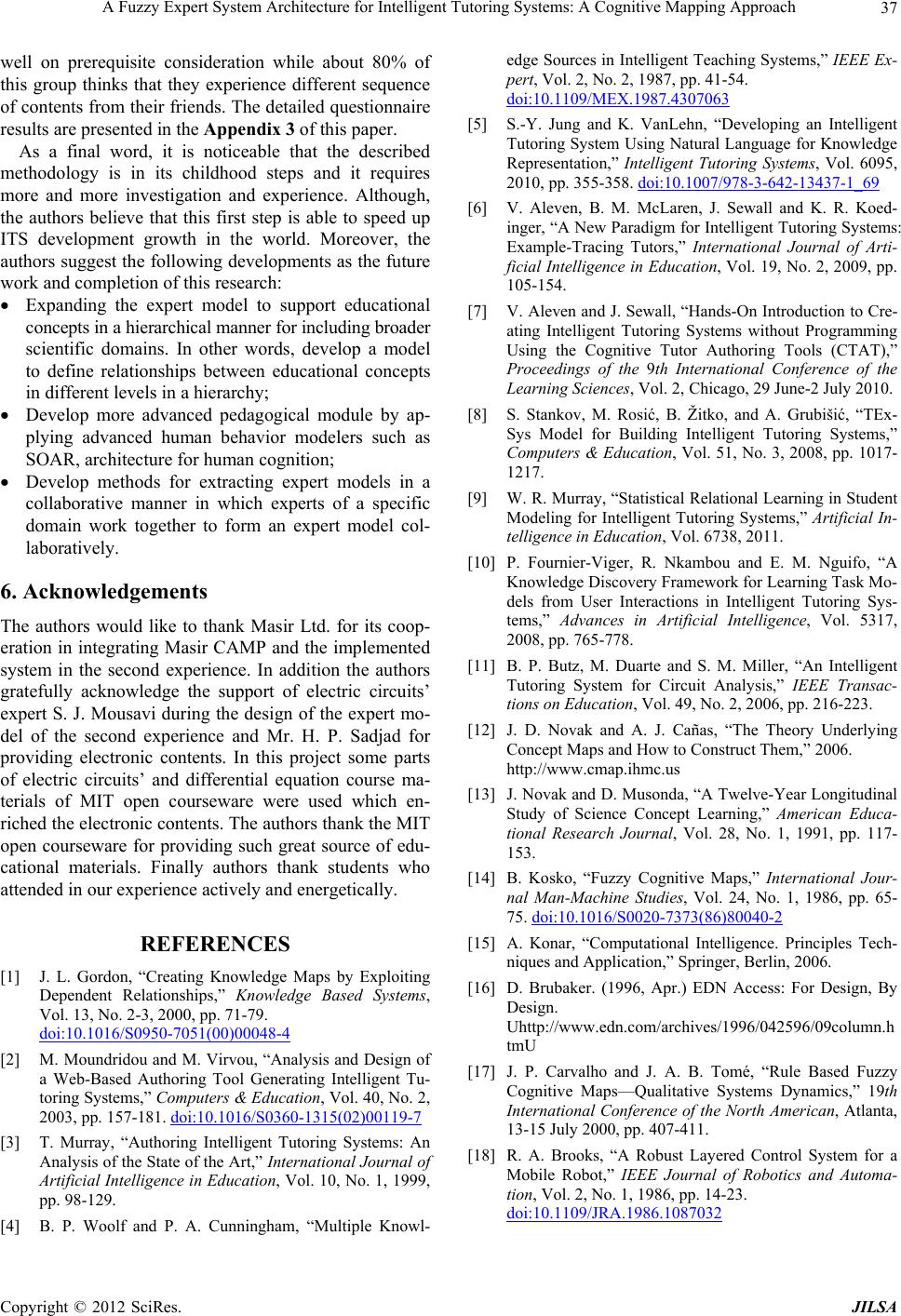
A Fuzzy Expert System Architecture for Intelligent Tutoring Systems: A Cognitive Mapping Approach
Copyright © 2012 SciRes. JILSA
37
well on prerequisite consideration while about 80% of
this group thinks that they experience different sequence
of contents from their friends. The detailed questionnaire
results are presented in the Appendix 3 of this paper.
As a final word, it is noticeable that the described
methodology is in its childhood steps and it requires
more and more investigation and experience. Although,
the authors believe that this first step is able to speed up
ITS development growth in the world. Moreover, the
authors suggest the following developments as the future
work and completion of this research:
Expanding the expert model to support educational
concepts in a hierarchical manner for including broader
scientific domains. In other words, develop a model
to define relationships between educational concepts
in different levels in a hierarchy;
Develop more advanced pedagogical module by ap-
plying advanced human behavior modelers such as
SOAR, architecture for human cognition;
Develop methods for extracting expert models in a
collaborative manner in which experts of a specific
domain work together to form an expert model col-
laboratively.
6. Acknowledgements
The authors would like to thank Masir Ltd. for its coop-
eration in integrating Masir CAMP and the implemented
system in the second experience. In addition the authors
gratefully acknowledge the support of electric circuits’
expert S. J. Mousavi during the design of the expert mo-
del of the second experience and Mr. H. P. Sadjad for
providing electronic contents. In this project some parts
of electric circuits’ and differential equation course ma-
terials of MIT open courseware were used which en-
riched the electronic contents. The authors thank the MIT
open courseware for providing such great source of edu-
cational materials. Finally authors thank students who
attended in our experience actively and energetically.
REFERENCES
[1] J. L. Gordon, “Creating Knowledge Maps by Exploiting
Dependent Relationships,” Knowledge Based Systems,
Vol. 13, No. 2-3, 2000, pp. 71-79.
doi:10.1016/S0950-7051(00)00048-4
[2] M. Moundridou and M. Virvou, “Analysis and Design of
a Web-Based Authoring Tool Generating Intelligent Tu-
toring Systems,” Computers & Education, Vol. 40, No. 2,
2003, pp. 157-181. doi:10.1016/S0360-1315(02)00119-7
[3] T. Murray, “Authoring Intelligent Tutoring Systems: An
Analysis of the State of the Art,” International Journal of
Artificial Intelligence in Education, Vol. 10, No. 1, 1999,
pp. 98-129.
[4] B. P. Woolf and P. A. Cunningham, “Multiple Knowl-
edge Sources in Intelligent Teaching Systems,” IEEE Ex-
pert, Vol. 2, No. 2, 1987, pp. 41-54.
doi:10.1109/MEX.1987.4307063
[5] S.-Y. Jung and K. VanLehn, “Developing an Intelligent
Tutoring System Using Natural Language for Knowledge
Representation,” Intelligent Tutoring Systems, Vol. 6095,
2010, pp. 355-358. doi:10.1007/978-3-642-13437-1_69
[6] V. Aleven, B. M. McLaren, J. Sewall and K. R. Koed-
inger, “A New Paradigm for Intelligent Tutoring Systems:
Example-Tracing Tutors,” International Journal of Arti-
ficial Intelligence in Education, Vol. 19, No. 2, 2009, pp.
105-154.
[7] V. Aleven and J. Sewall, “Hands-On Introduction to Cre-
ating Intelligent Tutoring Systems without Programming
Using the Cognitive Tutor Authoring Tools (CTAT),”
Proceedings of the 9th International Conference of the
Learning Sciences, Vol. 2, Chicago, 29 June-2 July 2010.
[8] S. Stankov, M. Rosić, B. Žitko, and A. Grubišić, “TEx-
Sys Model for Building Intelligent Tutoring Systems,”
Computers & Education, Vol. 51, No. 3, 2008, pp. 1017-
1217.
[9] W. R. Murray, “Statistical Relational Learning in Student
Modeling for Intelligent Tutoring Systems,” Artificial In-
telligence in Education, Vol. 6738, 2011.
[10] P. Fournier-Viger, R. Nkambou and E. M. Nguifo, “A
Knowledge Discovery Framework for Learning Task Mo-
dels from User Interactions in Intelligent Tutoring Sys-
tems,” Advances in Artificial Intelligence, Vol. 5317,
2008, pp. 765-778.
[11] B. P. Butz, M. Duarte and S. M. Miller, “An Intelligent
Tutoring System for Circuit Analysis,” IEEE Transac-
tions on Education, Vol. 49, No. 2, 2006, pp. 216-223.
[12] J. D. Novak and A. J. Cañas, “The Theory Underlying
Concept Maps and How to Construct Them,” 2006.
http://www.cmap.ihmc.us
[13] J. Novak and D. Musonda, “A Twelve-Year Longitudinal
Study of Science Concept Learning,” American Educa-
tional Research Journal, Vol. 28, No. 1, 1991, pp. 117-
153.
[14] B. Kosko, “Fuzzy Cognitive Maps,” International Jour-
nal Man-Machine Studies, Vol. 24, No. 1, 1986, pp. 65-
75. doi:10.1016/S0020-7373(86)80040-2
[15] A. Konar, “Computational Intelligence. Principles Tech-
niques and Application,” Springer, Berlin, 2006.
[16] D. Brubaker. (1996, Apr.) EDN Access: For Design, By
Design.
Uhttp://www.edn.com/archives/1996/042596/09column.h
tmU
[17] J. P. Carvalho and J. A. B. Tomé, “Rule Based Fuzzy
Cognitive Maps—Qualitative Systems Dynamics,” 19th
International Conference of the North American, Atlanta,
13-15 July 2000, pp. 407-411.
[18] R. A. Brooks, “A Robust Layered Control System for a
Mobile Robot,” IEEE Journal of Robotics and Automa-
tion, Vol. 2, No. 1, 1986, pp. 14-23.
doi:10.1109/JRA.1986.1087032